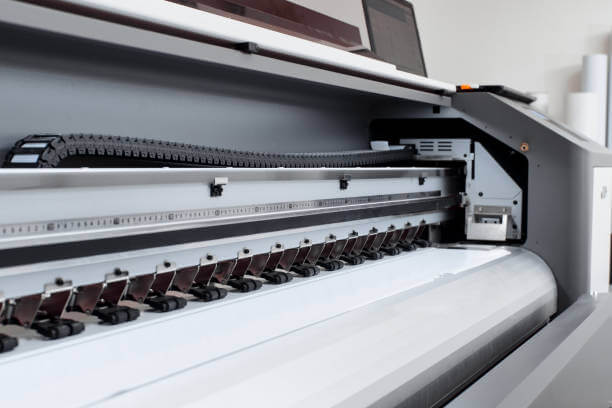What is Dye-Sublimation printer?
Dye-sublimation printer is a digital printing technology. Other names for it include direct sublimation and digital sublimation. This print method uses full-color graphics. It is most often used for signs, banners, fabrics, and clothing. These items usually have a (polymer-like) surface.

Dye-sublimation uses a mix of CMYK (cyan, magenta, yellow, and black) colors. It prints high-density graphics onto man-made fabrics and textiles. It does this through a combination of heat and pressure. The transferred images become part of the substrate. This results in a permanently embedded image.
The Dye-Sublimation Printing Process
Heat transfer technology is used in dye-sublimation to imprint on printed materials. It follows a two-part process. First, the dye transfers to sublimation paper. Then, it fixes to the substrate, fabric, or print material.
Step 1
Liquid gel ink transfers sublimation dyes onto high-release transfer paper.
Step 2
The transfer papers are then transferred from the paper onto the substrate material. The heat and pressure of the printing press ensure the dye penetrates the substrate. This converts the dye into a gaseous form without a noticeable liquid form. It also produces a permanent and durable color bond. The dye solidifies when we remove the heat.
At the molecular level, this process fuses the dyes. Unlike screen printing, it does not fade crack, or peel under everyday weathering nick.
Large Format Dye-Sublimation Printer Finest Uses
The material substrate is appropriate for sublimation printing if it can absorb a dye. These materials can include:
Acrylic
Aluminium
Ceramics
Fibreglass
Glass
Plastic
The high heating processes involved often exceed 200 degrees Centigrade. This can cause substrate melting. Always consider substrate melting temperatures.
Dye-sublimation fabric printing
You can use PVC materials to make fabrics like theatrical backdrops and flags. They need flexibility and are often printed using dye-sublimation. Fabrics prepared for sublimation can display soft and gentle print patterns. The colors are vibrant and durable.
Dye-sublimation banner printing
For dye-sublimation printing, polyester or PVC signs are perfect for outdoor signs. This printing method allows for photographic-quality prints. It highlights corporate branding and retail signage.
Dye-Sublimation vs Inkjet Printing
The heat processes involved are the main distinction between dye-sublimation and inkjet printing. The transfer paper’s dye is pressed onto the substrate by the rollers. This requires very high temperatures. Whereas inkjet printers do not even get close to these kinds of temperatures.

Sublimation allows gaseous color dyes to penetrate the substrate’s surface. This is another important difference. This is because of this. This makes the dyes a permanent part of the surface. Inkjet inks cannot meet such permanent color bonding. It allows sublimated prints to last longer. They can endure more hostile environments than inkjet prints.
Yet, dye-sublimation has a big drawback. It cannot print onto many natural products without a polymer coating to receive the dye.
When it comes to print quality inkjet technology is fast improving. Dye-sublimation can print colors in a continuous tone. This ensures a smooth, photographic quality to the graphics. Inkjet printing has advanced to produce microscopic ink droplets. This advancement results in superior images.
Benefits and Drawbacks of Large Format Dye-Sublimation Printing Technology
There are several advantages to using dye-sublimation. Most are due to its simple technology. For example, dye-sublimation printers generally have fewer moving parts. This means they are less likely to break down and can print over large surface areas at once.
No drying time
The sublimation-dye method prints on fabric. As soon as it comes out of the printer, you can pack, wear, or fold the fabric. There’s no risk of smearing, unlike other print methods.
Mess-free/Fade-free
The ink isn’t stored as a liquid so there are no risks of spillage. These dyes penetrate the print material, making it less prone to fading. Furthermore, it will not degrade plastic substrates. It also won’t be a risk to running when exposed to water.
High fidelity graphics
Its continuous-tone technology allows each dot to be printed in a different color. Dye-sublimated prints can have high-resolution graphics and remain for a very long time. They maintain photographic quality prints.
Small order friendly
Dye-sublimation uses no water. Its energy requirements are smaller than other printers. You can be prepared for small batch orders and one-off prints. Its unique ability allows flexible customization.
But, dye-sublimation isn’t the best choice for every print job. There will be a few drawbacks to take into account:
Recycling and waste
Dye-sublimation can produce a lot of non-recyclable waste. This happens because the process has two parts used to transfer to the substrate. No other print process needs this two-step process. Once used, these transfer papers cannot be reused.
Limited substrate suitability
Sublimated printing isn’t ideal for some natural fibers like paper. It works best on materials with a polymer coating.
Light vs dark
As the name suggests, dye-sublimation dyes the substrate material. It doesn’t print on it. Thus, using lighter-colored substrates has a greater visual impact than using black data.
Conclusion
A dye-sublimation printer uses heat to transfer dye to metal, paper, plastic, and fabric. This type of printer is used for various materials. The process involves sublimating solid dye particles into a gas. The gas permeates the material’s surface and solidifies. This results in vibrant, durable prints. Dye-sublimation printers are used for producing high-quality images. They are used on items like apparel, mugs, photo paper, and other promotional products. The technology is known for its ability to create detailed and long-lasting prints. They have a smooth finish.

